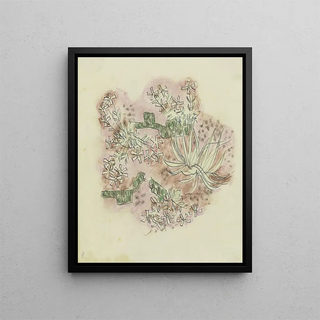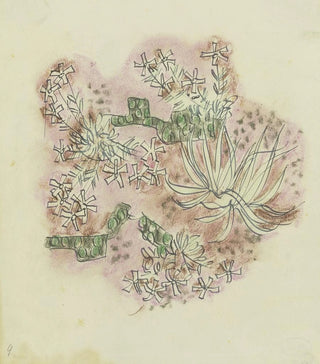Art print | Study of Plants 3 - August Babberger


View from behind

Frame (optional)
In a world where nature reveals itself as an inexhaustible source of inspiration, the artwork "Study of Plants 3" by August Babberger stands as a true tribute to botanical beauty. This piece, both delicate and striking, immerses us in a universe where every leaf, every petal seems to tell a story. The finesse of details and the harmony of colors invite the viewer to a meditative contemplation, revealing the magic that resides in the forms of nature. Through this work, Babberger offers us an entry point into a secret garden, where art and botany intertwine gracefully.
Style and uniqueness of the work
The artwork "Study of Plants 3" is distinguished by its meticulous and poetic approach. Babberger excels in botanical representation, blending realism with an almost lyrical sensitivity. The shades of green, the play of light and delicate shadow give each plant an almost living dimension. This art print does not merely reproduce nature; it interprets it, infusing it with a soul. The textures are rendered with such precision that one can almost feel the freshness of the leaves and the delicacy of the flowers. The composition, carefully balanced, guides the eye through a visual journey, where each element finds its place in perfect harmony. Thus, the art print transcends simple botanical study to become a celebration of life, a visual poem dedicated to nature.
The artist and his influence
August Babberger, an artist at the crossroads of science and art, has established himself in the artistic landscape through his unique approach. Influenced by the great masters of botanical painting, he has developed a style that is entirely his own, combining scientific rigor with artistic sensitivity. His work reflects a deep passion for nature and a desire to transmit its beauty to the world. Babberger does not limit himself to capturing the appearance of plants; he explores their meanings, their stories, and their place in the ecosystem. His influence extends beyond the boundaries of art, inspiring many contemporary artists to rediscover the richness of the plant world. Through his works, he invites everyone to embrace

Matte finish

View from behind

Frame (optional)
In a world where nature reveals itself as an inexhaustible source of inspiration, the artwork "Study of Plants 3" by August Babberger stands as a true tribute to botanical beauty. This piece, both delicate and striking, immerses us in a universe where every leaf, every petal seems to tell a story. The finesse of details and the harmony of colors invite the viewer to a meditative contemplation, revealing the magic that resides in the forms of nature. Through this work, Babberger offers us an entry point into a secret garden, where art and botany intertwine gracefully.
Style and uniqueness of the work
The artwork "Study of Plants 3" is distinguished by its meticulous and poetic approach. Babberger excels in botanical representation, blending realism with an almost lyrical sensitivity. The shades of green, the play of light and delicate shadow give each plant an almost living dimension. This art print does not merely reproduce nature; it interprets it, infusing it with a soul. The textures are rendered with such precision that one can almost feel the freshness of the leaves and the delicacy of the flowers. The composition, carefully balanced, guides the eye through a visual journey, where each element finds its place in perfect harmony. Thus, the art print transcends simple botanical study to become a celebration of life, a visual poem dedicated to nature.
The artist and his influence
August Babberger, an artist at the crossroads of science and art, has established himself in the artistic landscape through his unique approach. Influenced by the great masters of botanical painting, he has developed a style that is entirely his own, combining scientific rigor with artistic sensitivity. His work reflects a deep passion for nature and a desire to transmit its beauty to the world. Babberger does not limit himself to capturing the appearance of plants; he explores their meanings, their stories, and their place in the ecosystem. His influence extends beyond the boundaries of art, inspiring many contemporary artists to rediscover the richness of the plant world. Through his works, he invites everyone to embrace






